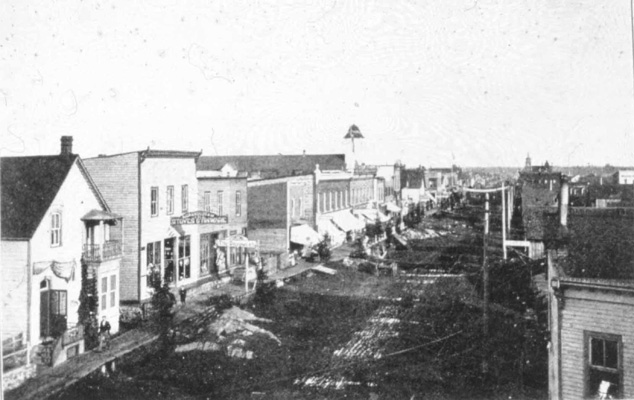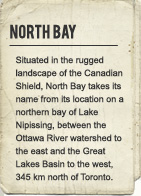Situated in the rugged landscape of the Canadian Shield, North Bay takes its name from its location on a northern bay of Lake Nipissing, between the Ottawa River watershed to the east and the Great Lakes Basin to the west, 345 km north of Toronto. The town emerged as a frontier post on the newly established Canadian Pacific Railroad line in 1882. From little more than a log cabin owned by town-founder John Ferguson, the town quickly added a supply store, a post office and a sawmill for the burgeoning lumber industry.
North Bay also prospered in the late 19th and early 20th centuries as a railroad town. The CPR competed with the Temiskaming and Northern Ontario Railway and the Canadian National Railway for lucrative shares in the market for rail transportation. The process of blasting through the Canadian Shield for the building of the railway lines led to the discovery of cobalt as well as other valuable minerals such as gold, silver, copper and nickel. In 1922, the town built a memorial commemorating the soldiers of the First World War that featured the largest cast bronze statue in Canada at the time.
North Bay was incorporated in August 1925. The city became a popular tourist destination for curiosity-seekers after the birth of the Dionne quintuplets in 1934, the first quintuplets known to survive infancy. The population includes a large number of people of French-Canadian descent as well as sizeable Dutch, Italian, Scandinavian and German communities. In 1968 the city amalgamated with West Ferris and Widdifield townships.
Originally located along a fur-trading route, the district of Nipissing retains a major fur trade today. Its wild-fur auctions are among the largest in the world. Additional income and activity are generated by Wing 22 of the Canadian Forces Base North Bay, Canada’s major military base of operations for participation in the North American Aerospace Defence Command (NORAD). There are two local post-secondary educational institutions: Canadore College, founded in 1967 and Nipissing University received its charter in 1992. Tourism, much of it based in the exhilarating natural beauty of the region’s outdoor parks and trails, is also a major employer in the region. When St. Joseph’s Hospital was consolidated with the North Bay Civic Hospital in 1995, the city emerged as a major regional centre for health care, building a multimillion dollar addictions and mental health care unit. The city also remains a major travel hub, as the largest city between Sudbury and Ottawa, along the junction of Highway 11 and Highway 17. In 2006, the total population measured over 53,000 people.









